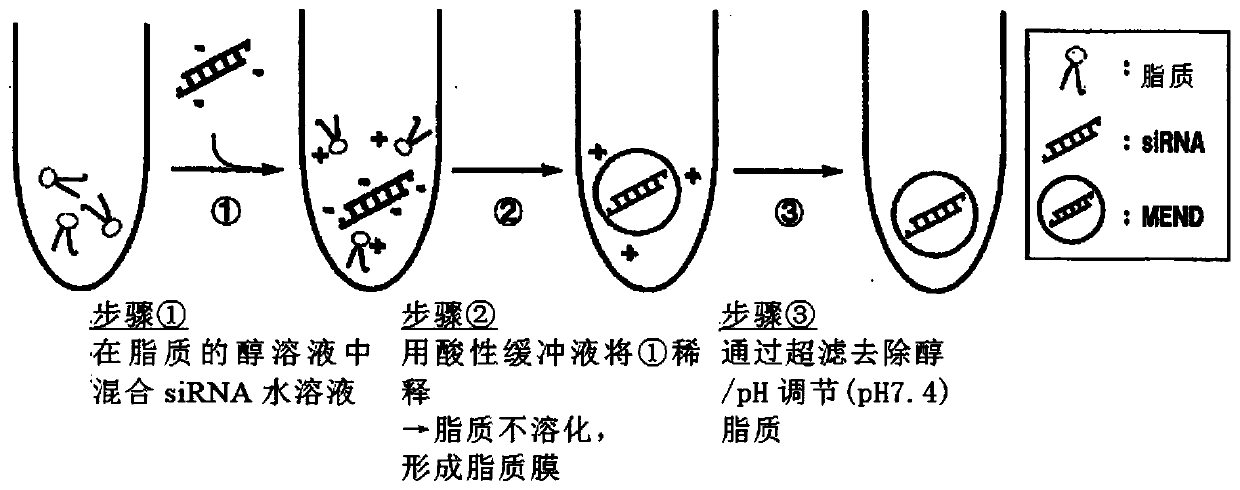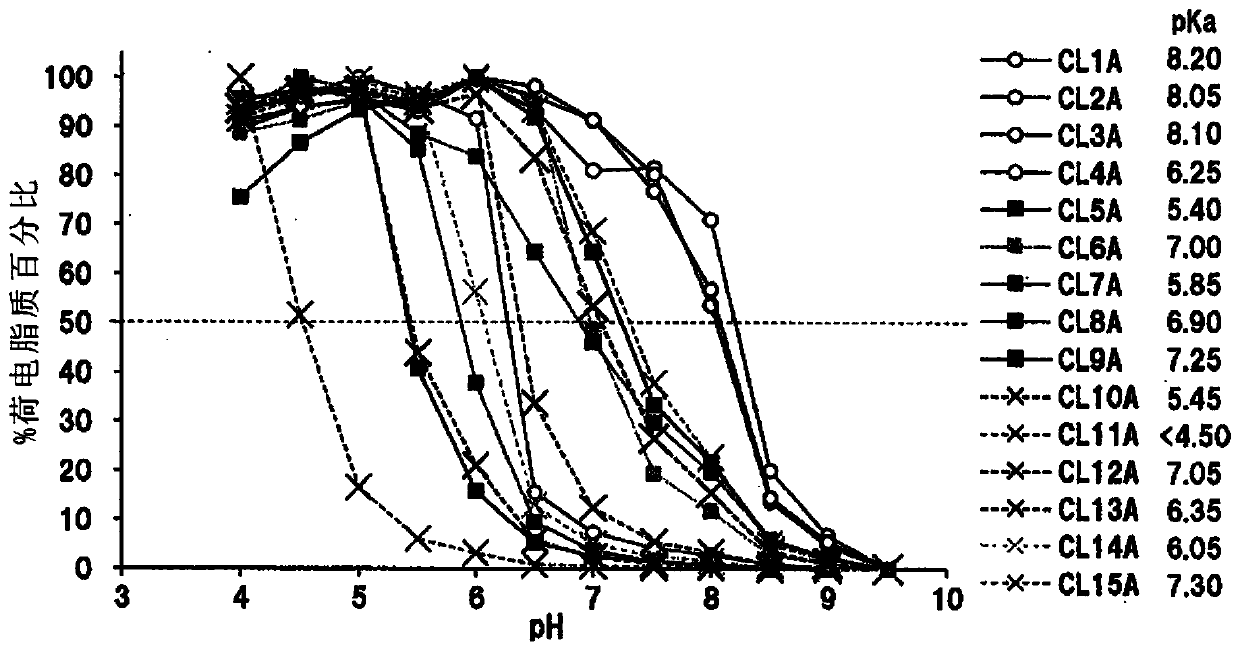Lipid membrane structure for delivery into sirna cell
A technology of structure and lipid, which is applied in the direction of liposome delivery, antibody, medical preparation of non-active ingredients, etc., and can solve the problem of reduced siRNA delivery activity and other issues
- Summary
- Abstract
- Description
- Claims
- Application Information
AI Technical Summary
Problems solved by technology
Method used
Image
Examples
example 1
[0166] The lipid compound of the present invention was synthesized according to the following scheme. When the hydrophobic scaffold is the same as YSK12 (Patent Document 6), that is, when synthesizing a lipid in which c in the general formula (A) is 0, linoleic acid (compound A) is used as a starting material. After reduction of linoleic acid with lithium aluminum hydride (compound B), activation by mesylation of the hydroxy group (compound C), bromination by exposure to magnesium bromide (compound D). Grignard reaction was carried out using δ-valerolactone as a substrate to connect two (2) linoleic acid-derived hydrophobic scaffolds (compound E). When the tertiary amino group is directly bonded to the hydrocarbon chain, the primary hydroxyl group is activated by tosylation (compound F), and the amino group is introduced by a nucleophilic substitution reaction.
[0167] On the other hand, when a tertiary amino group is bonded via an ester bond, it is connected by dehydration ...
example 2
[0404] Hydrophobic scaffolds were pH-sensitive cationic lipids derived from linoleic acid and having various hydrophilic sites. LNP is based on the method of the example (Example 2) of Patent Document 6, each pH-sensitive cationic lipid, cholesterol, methoxypolyethylene glycol 2000 dimyristoylglycerol (PEG-DMG 2000) is set as a mole Ratio 50:50:0.75-1.5, by alcohol dilution method ( figure 1 ) for modulation. The average particle diameter calculated by the phase light scattering method is 80-120nm, and the siRNA loading rate is above 90%.
[0405] The pKa of each LNP was determined using p-toluenesulfonic acid (TNS). TNS (final concentration: 0.75 μM) and LNP (final concentration: 30 μM) were mixed in a buffer adjusted to each pH, and the fluorescence intensity was measured with a microplate reader. The highest value and the lowest value were set as 100% and 0% charge, respectively, and the pH at which the charge rate was 50% was set as pKa for calculation. As a result,...
example 3
[0409] Two types of hydrophilic sites, CL4 and CL15, were fixed, and the effect of changing the chemical structure of the hydrophobic scaffold was evaluated in the same manner as in Example 2. When using TNS to measure pKa, CL4 is 6.25-6.40, CL15 is 6.80-7.25, and the influence brought by the change of hydrophobic scaffold structure is not observed ( Figure 4A and 4B ). With regard to in vitro knockdown activity, derivatives other than CL15B outperformed previous CL15A with a hydrophobic scaffold ( Figure 5 ). In particular, CL15H having oleic acid as a hydrophobic scaffold exhibited about three times higher activity than CL15A. Regarding the F7 knockdown activity in vivo, the activities of the hydrophobic scaffolds C and D of CL4 and CL15 were all low, while the hydrophobic scaffold H showed the same level of activity as the hydrophobic scaffold A ( Figure 6A and Figure 6B ).
[0410] In particular, for CL4H showing high F7 knockdown activity, the formulation formul...
PUM
| Property | Measurement | Unit |
|---|---|---|
| diameter | aaaaa | aaaaa |
| particle size | aaaaa | aaaaa |
Abstract
Description
Claims
Application Information
 Login to View More
Login to View More - R&D
- Intellectual Property
- Life Sciences
- Materials
- Tech Scout
- Unparalleled Data Quality
- Higher Quality Content
- 60% Fewer Hallucinations
Browse by: Latest US Patents, China's latest patents, Technical Efficacy Thesaurus, Application Domain, Technology Topic, Popular Technical Reports.
© 2025 PatSnap. All rights reserved.Legal|Privacy policy|Modern Slavery Act Transparency Statement|Sitemap|About US| Contact US: help@patsnap.com



